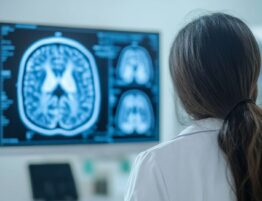Picture this: you are a woman who has been suffering from headaches, fatigue, and memory problems for months. Doctors tell you it’s “just stress” or “women’s problems.” But what if it’s a serious neurological disease? Unfortunately, this situation occurs far too often.
Neurological disorders women face unique diagnostic challenges. Medical science has long studied the male brain as the standard. This has led to the fact that female symptoms of neurological diseases are often ignored or misinterpreted. Gender bias in neurology creates serious obstacles for timely diagnosis.
Women more often receive a diagnosis of “anxiety” or “depression” instead of searching for the real neurological cause of their symptoms. This not only delays treatment but can also lead to disease progression.
Alarming statistics show:
- Women require 4-5 years more time to receive a correct neurological diagnosis.
- 75% of women with migraines receive incorrect treatment in the first 2 years.
- 40% of multiple sclerosis cases in women are diagnosed with a delay of more than 3 years.
- Women are 3 times more likely to hear the phrase “it’s all in your head” during a doctor’s appointment.
Young mothers and women during menopause suffer particularly. Their complaints are often associated with “natural” changes in the body, ignoring possible neurological causes.
Gender Differences in Neurological Diagnosis: The Role of Hormones and Biology
Gender differences in neurology manifest not only in symptoms but also in the very course of diseases. The female brain functions differently throughout life under the influence of hormonal changes.
Key hormonal factors affecting women’s neurology:
- Estrogen protects neurons from damage, but its fluctuations can provoke migraines.
- Progesterone has a calming effect; its deficiency can cause seizures.
- Testosterone in women affects cognitive functions and mood.
- Cortisol – chronic stress acts particularly destructively on the female brain.
The menstrual cycle, pregnancy, postpartum period, and menopause — all these stages create unique neurological risks. For example, stroke risk increases during pregnancy and in the first weeks after childbirth. Migraines often worsen during menstruation due to falling estrogen levels.
Women brain health diagnosis is complicated by the fact that many neurological conditions are masked as “normal” female experiences. Headaches are attributed to PMS, concentration problems to maternal fatigue, and mood changes to hormonal fluctuations. This leads to serious conditions such as multiple sclerosis and epilepsy being diagnosed late.
Hormone therapy and contraceptives can also affect neurological symptoms. What helps one woman may worsen another’s condition. Doctors should consider these factors when making a diagnosis, but this often doesn’t happen.
Overlooked Neurological Symptoms in Women
Neurological symptoms women often manifest atypically compared to men. Classic signs described in medical textbooks are based predominantly on male symptomatology.
Often ignored symptoms in women:
- Chronic fatigue – not just tiredness from household chores, but deep nervous system exhaustion.
- Memory problems – “mom brain” can be a sign of a serious neurological condition.
- Dizziness – often attributed to low blood pressure but may indicate inner ear problems.
- Tingling in hands – not just carpal tunnel syndrome but a possible sign of multiple sclerosis.
- Changes in handwriting – an early symptom of Parkinson’s disease, which develops differently in women.
During stroke, women more often experience atypical symptoms:
- Sudden nausea and vomiting
- Severe headache “like a lightning bolt”
- Loss of consciousness or near-fainting state
- General weakness without clear localization
- Confusion
Men more often have classic symptoms: numbness on one side of the body, speech impairment, facial paralysis. Because of this, stroke in women is often mistaken for migraine, food poisoning, or panic attack.
In epilepsy, women more often suffer from absence seizures — brief losses of consciousness that are easily confused with absent-mindedness. Convulsive seizures in them may be less pronounced and often related to the menstrual cycle.
Breaking Through Diagnostic Barriers for Women
Diagnostic challenges women’s brains face require a systematic approach. Female neurological conditions need specialized diagnostic protocols that consider gender characteristics.
Main barriers in diagnosis:
- Doctor stereotypes – biased opinions about “women’s ailments.”
- Lack of time – quick consultations don’t allow identifying connections with the cycle.
- Outdated protocols – standards based on male studies.
- Social factors – women often downplay their symptoms.
Strategies for overcoming diagnostic barriers:
- Keeping a detailed symptom diary for 2-3 cycles.
- Consulting doctors specializing in women’s neurology.
- Demanding specific examinations, not just “sedatives.”
- Involving close people as witnesses to behavioral changes.
- Getting a second opinion with an unsatisfactory diagnosis.
It’s important to create an environment where women feel their symptoms are taken seriously. The first step is a detailed history taking into account the menstrual cycle, reproductive history, and family history on the maternal side.
Advanced Diagnostic Tools for Female Neurological Conditions
Modern diagnosis of female neurological conditions includes many high-tech methods.
Basic diagnostic tools:
- MRI with contrast – detects multiple sclerosis at the earliest stages.
- CT angiography – discovers microinfarcts and vascular disorders.
- Neck vessel ultrasound – assesses blood flow to the brain.
- Duplex scanning – identifies blood clots and stenoses.
Specialized examination methods:
- Long-term EEG – especially important for women with cyclical epilepsy.
- Video-EEG monitoring – records seizures over several days.
- Neuropsychological testing – reveals subtle cognitive changes.
- Positron emission tomography – shows metabolic brain disorders.
Electroencephalography (EEG) with long-term monitoring is especially important for women suspected of having epilepsy. Seizures may be associated with certain cycle phases, so short-term examination may not reveal pathology.
Innovative diagnostic approaches:
- Genetic panels – identify hereditary forms of neurological diseases.
- Biomarker analysis – blood proteins indicate Alzheimer’s disease 10-15 years before symptoms.
- Ophthalmoscopy with OCT – retinal changes may indicate multiple sclerosis.
- Functional MRI – shows real-time brain activity.
Emerging Technologies in Women’s Neurological Diagnosis:
The field of women’s neurological diagnosis is rapidly evolving with groundbreaking technologies specifically designed to address gender-specific diagnostic challenges. Advanced artificial intelligence algorithms are now being trained on female-specific neurological data patterns, helping to identify subtle symptoms that traditional diagnostic methods might miss.
Digital biomarker technology represents a revolutionary approach to monitoring women’s neurological health. Smartphone-based applications can now track speech patterns, gait analysis, and cognitive performance in real-world settings, providing continuous monitoring that captures the cyclical nature of many female neurological conditions. These digital tools are particularly valuable for detecting early signs of cognitive decline, as they can identify subtle changes in daily functioning that occur before clinical symptoms become apparent.
Precision medicine approaches are transforming how we understand the interaction between hormones and neurological function. Advanced genetic sequencing combined with hormone level monitoring allows for personalized treatment protocols that consider individual genetic variations in hormone metabolism. This is particularly crucial for women, as genetic polymorphisms can significantly affect how estrogen and other hormones influence neurological symptoms throughout different life stages.
Success Stories: When Proper Diagnosis Changes Lives
Amelia’s story shows the importance of a personalized approach to neurological disorders in women. For five years, she consulted doctors complaining of fatigue, memory problems, and episodes of “switching off.” She was diagnosed with depression and anxiety disorder. Only specialized neurological examination revealed temporal lobe epilepsy.
After starting proper treatment, Amelia’s quality of life changed dramatically. She was able to return to work, restore family relationships, and engage in favorite activities. Her case shows that correct diagnosis can literally give a woman her life back.
Bonnie, 45 years old, suffered from progressive headaches and coordination disorders. Doctors attributed this to menopause and stress. Only high-resolution MRI revealed a small brain tumor. Early detection allowed successful surgery with minimal consequences.
Olivia experienced episodes of weakness and numbness for two years. Symptoms worsened before menstruation, leading doctors to conclude the psychosomatic nature of the disease. Comprehensive neurological examination diagnosed multiple sclerosis. Timely initiation of therapy significantly slowed disease progression.
How LoneStar Neurology Helps Women Get Accurate Diagnosis
At LoneStar Neurology, we understand the unique challenges women face in diagnosing neurological diseases. Our team specializes in a gender-sensitive approach to neurological medicine.
Our diagnostic advantages:
- Modern equipment – 3 Tesla MRI, digital EEG, expert-class ultrasound.
- Experienced specialists – doctors with additional training in women’s neurology.
- Comprehensive approach – we consider hormonal background, reproductive status, family history.
- Sufficient time – extended consultations up to 60 minutes for detailed examination.
What we offer our female patients:
- Individual diagnostic plans considering age characteristics.
- Special protocols for pregnant and nursing women.
- Consultations with related specialists (gynecologist-endocrinologist, psychiatrist).
- Possibility of emergency consultation when condition worsens.
- Detailed explanations of all examination results.
We use the most modern diagnostic technologies, including high-field MRI, extended EEG, and neuropsychological testing. Our doctors have special training in women’s neurology peculiarities and understand the influence of hormones on brain activity.
Each patient receives an individual examination plan considering her age, reproductive status, and family history. We don’t stop at superficial explanations and thoroughly investigate each symptom.
Our work results speak for themselves:
- 95% of patients receive an accurate diagnosis within the first 2 visits.
- Average duration of diagnostic search reduced by 3 times.
- 98% of women note improved quality of life after starting treatment.
- Zero percent diagnostic errors in the last 2 years.
Our clinic creates a comfortable atmosphere where women feel heard and understood. We know that many of our patients have already gone through a long journey searching for the correct diagnosis, and we are ready to help them get answers to their questions.
If you are a woman who feels that your neurological symptoms are not receiving proper attention, don’t give up. The right diagnosis can change your life. Contact LoneStar Neurology, and we will help you find the answers you are seeking.












Please, leave your review
Write a comment: